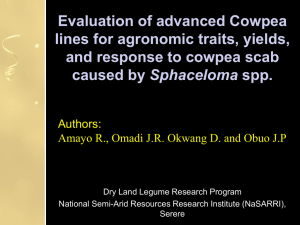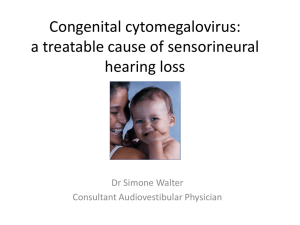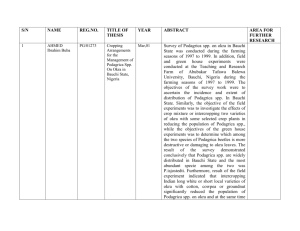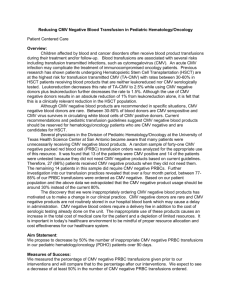3. Serological detection of seed-borne cowpea viruses in uganda
advertisement
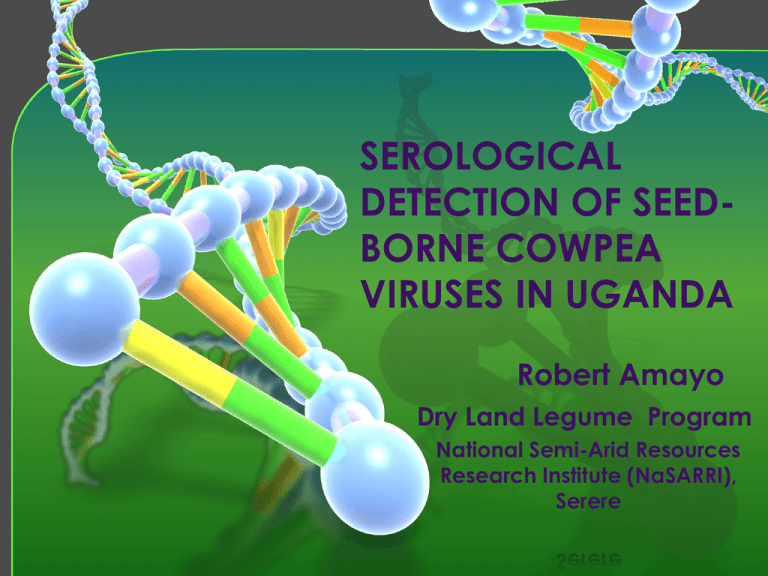
SEROLOGICAL DETECTION OF SEEDBORNE COWPEA VIRUSES IN UGANDA Robert Amayo Dry Land Legume Program National Semi-Arid Resources Research Institute (NaSARRI), Serere Authors Amayo Robert (MSc.) Edema Richard (PhD) Arinaitwe Abel B. (MSc.) Rubaihayo Peter R. (DSc.) Settumba Mukasa B. (PhD) Tusiime Geoffrey (PhD) Content of Presentation Item 1 Research Background Item 2 Research Objectives Item 3 Research Methodology Item 4 Research Results and Discussion Item 5 Conclusion and Recommendation Item 5 Acknowledgement Research Background • Cowpea production in Uganda ranks 3rd after beans and groundnuts. • 90% of the crop is grown in Semi-arid region of the country. • Production level and yield of the crop has continued to be low • Biotic factors are major contributors to the above. • Diseases caused by viruses can cause up to 100% grain yield loss. • This is exacerbated by lack of or limited knowledge on presence of the diseases. Research Objectives To estimate the prevalence and relative importance of viruses causing diseases in cowpea fields in Uganda. Through: • • • • Assessed the incidence and severity of virus-like diseases in cowpea fields Identified cowpea viruses that are seed-borne Evaluated the effect of the virus diseases on performance of selected cowpea lines Assessed the seed transmission potential of three major seed-borne viruses. Research Methodology Field survey and sample collection Two surveys were carried out two growing seasons in 7 districts as shown in the figure. • Disease incidence and severity were scored as described (Gumedzoe et al., 1997; Madden and Hughes, 1999) Leaf and seed samples were collected From at least 10 cowpea fields per districts. • • Sampling was carried out as described by Nutter et al. (1997). The samples were bagged separately for further assessment in the laboratory and screenhouse. Symptom Expression Research Methodology cont’d Laboratory Work • Double Antibody Sandwich Enzyme Linked Immuno-Sorbent Assay (DAS-ELISA) was used for diagnosis. • • Viruses extracts from crushed leaf samples and finely ground seed samples were detected as described by Clark and Adams (1977) and Koenraadt and Remeeus (2006), respectively. A modified Reverse Transcriptase-Polymorphic Chain Reaction protocol (Gillaspie et al., 2001) was used to confirm the presence of three most common viruses. The presence of 9 cowpea viruses were assessed namely; CMV, CPMMV, CPMoV, CCMV, CYMV, CPSMV, CABMV, SBMV and CPMV Research Methodology Cont’d Virus infection effects Study • • Seedlings for 4 cowpea lines grown in plastic pots were inoculated with different viruses and virus combination. Disease data was collected 14 DPI till maturity. Seed transmission potential study • • Seed samples that tested positive for 3 most important viruses were used. 2 - 3 seedlings were maintained per pot. 21 DPG, leaf samples from seedlings assessed for the viruses. This was repeated twice at 28 and 35 DPG. Incidences of cowpea viruses detected in leaf and seed samples collected from farmers’ fields in Eastern and West Nile regions of Uganda CPMV CPSMV CCMV + + + + + - + + CPMoV + SBMV CYMV Eastern Region CMV Virus Incidence (%) CPMMV Viruses detected CABMV Location Pallisa 73.6 (42.8) 16(6) 4(2) 22(2) 0(2) 7(4) 4(1) 0(0) 20(1) 16(2) Kumi 72.7 (37.0) 27(3) 4(2) 24(1) 0(0) 11(8) 13(1) 0(0) 18(1) 13(3) Soroti 87.5 (58.8) 20(4) 4(7) 13(3) 0(2) 11(5) 11(1) 0(0) 16(2) 11(3) + + + + + + + + 7(0) 9(0) 0(0) 2(0) 7(0) West Nile Nebbi 87.6 (0.0) 11(0) 2(0) 4(0) 0(0) Arua 47.5 (36.4) 22(0) 0(4) 2(0) 0(0) 4(0) 4(0) 0(0) 20(0) 0(0) Yumbe 48.6 (85.7) 2(0) 0(1) 2(2) 0(0) 2(0) 11(0) 0(0) 2(0) 0(2) Moyo 73.6 (50.0) 7(0) 11(3) 18(4) 0(0) 7(3) 9(0) 1(0) 2(0) 9(1) MUARIK 66.1 (96.7) 29(23) 6(7) 8(31) 0(0) 17(0) 9(0) 1(0) 18(0) 10(1) F. Prob. < 0.01 1 2 3 4 5 6 1000 500 200 RT-PCR gel picture: Lower bands in Lanes 3, 4 and 6 are for CABMV, while the upper bands in lanes 2 and 4 are for CMV. Lane 5 is for a negative control and lane 1 is 1kb size marker. Effect of single and multiple virus infections on plant height, number of pods, weight, and the RAUDPC of cowpea plants grown in screen house at MUARIK. Yield and yield components* Ht/cm at 5 WAE Virus and combinations Healthy (Control) CMV CPMMV CPMoV CCMV CYMV CPMV CABMV CMV+CPMMV CMV+CPMoV CMV+CCMV CMV+CABMV CCMV+CPMoV CABMV+CPMoV CCMV+CPMoV+CMV CMV + CPMoV + CABMV CMV + CPMMV + CCMV CPMMV+ CPMoV + CCMV CMV + CPMoV + CYMV + CCMV 59.75 46.67 54.50 49.92 65.25 63.42 57.92 39.75 51.58 42.17 50.25 43.58 49.67 50.50 45.00 48.92 52.83 47.50 52.33 CCMV+CMV+CPMoV+CABMV CCMV+CYMV+CABMV+CMV F. probability 43.67 31.67 <0.001 No. of pods/ plant 5.92 1.75 1.58 1.75 2.58 2.92 2.33 1.25 2.17 1.33 1.67 1.50 1.83 1.83 1.25 1.58 1.67 1.08 1.42 1.50 0.67 <0.001 No. of seeds/ plant 74.83 25.75 21.08 21.42 32.75 37.42 30.75 13.50 27.33 19.33 23.58 21.33 24.67 23.92 19.50 21.58 25.17 14.92 21.83 Yield(g) / plant 19.67 8.83 <0.001 2.77 1.08 <0.001 9.10 3.05 2.48 2.35 3.65 4.46 3.72 1.49 3.05 2.34 3.04 2.54 3.24 2.92 2.95 3.02 3.13 2.05 3.12 RAUDP C 0.01 0.20 0.17 0.08 0.27 0.19 0.20 0.20 0.31 0.23 0.16 0.22 0.23 0.26 0.43 0.36 0.40 0.36 0.26 0.30 0.43 <0.001 Percentage reduction in yield and yield components Ht/cm at Number No. of Yield (g) 5 WAE of Pods/ seeds/ / plant plant plant 0.00 0.00 0.00 0.00 21.89 70.42 65.59 66.48 8.79 73.25 71.83 72.75 16.45 70.42 71.38 74.18 -9.21 56.35 56.23 59.89 -6.14 50.70 49.99 50.99 3.06 60.57 58.91 59.12 33.47 78.87 81.96 83.63 13.67 63.38 63.48 66.48 29.42 77.47 74.17 74.29 15.90 71.83 68.49 66.59 27.06 74.65 71.50 72.09 16.87 69.02 67.03 64.40 15.48 69.02 68.03 67.91 24.69 78.87 73.94 67.58 18.13 73.25 71.16 66.81 11.58 71.83 66.36 65.60 20.50 81.70 80.06 77.47 12.42 76.05 70.83 65.71 26.91 47.00 74.65 88.73 73.71 88.20 69.56 88.13 Variation in yield and yield components of cowpea varieties inoculated with different virus combinations. Cowpea Variety Yield and yield components* Plant No. of pods No. of height (cm) Seeds at 5 WAE 46.78 1.32 16.64 Yield (g) RAUDC 2.04 0.31 50.51 1.76 22.94 2.86 0.22 Secow 2W (Sec) 50.16 2.14 30.54 3.65 028 FE 69 (Fe) 51.95 2.32 30.70 3.93 0.17 Average mean F. prob. 49.85 0.005 1.88 < 0.001 25.20 < 0.001 3.12 0.001 0.25 < 0.001 Ichirikukwai (Ich) Ebelat (Ebe) Seed transmission levels of CMV, CPMMV and CABMV detected in seed samples from farmers’ fields in Uganda. Cowpea viruses * Number of infected seeds planted Number of seedlings Tested infected Seed transmission (%) CMV 110 87 20 23.0 CPMMV 165 133 27 20.3 CABMV 75 67 11 16.4 Conclusion and Recommendations Several viruses infect cowpea in Uganda and a large number of them are seed-borne. Multiple virus infections resulted in a significant decrease in yield and yield components. There was no significant difference in the seed transmission potential of three important seedborne viruses. There is need for the production and use of virus-free seed, breeding for virus resistance and adoption of efficient seed certification systems. Acknowledgement DANIDA THANK YOU!!


